Biology MCQ For NEET With Answers – Biology Ecosystem Miscellaneous
Question 1. The term biocoenosis was first of all used by Manipal
- Forbes
- Mobius
- Reiter
- Lindeman
Answer: 2. Mobius
Biocoenosis refers to all the organisms living in a particular place at a particular time. It is equivalent of a biome and is used especially in the ecological literature of Eastern Europe. The term ‘Biocoenosis’ is coined by Karl Mobius.
Question 2. Which of the following is false?
- Quantity of biomass in a trophic level at a particular period is called standing crop
- The energy content in a trophic level is determined by considering individuals of a species in that trophic level
- The succession that occurs in newly cooled lava is called primary succession
- Rate of succession is faster in secondary succession
“questions for ecology “
Answer: 2. The energy content in a trophic level is determined by considering individuals of a species in that trophic level
Option is false and can be corrected as The energy level in a trophic level is not determined by considering individuals of a species in that trophic level. Rest all statements are correct
Read And Learn More: NEET Biology Multiple Choice Question And Answers
Question 3. Find the correct statement.
- Low temperature and aerobic conditions inhibit decomposition
- Plants capture only 2-10% of the PAR and sustain the entire living world
- In aquatic and terrestrial ecosystems the GFC is the major conduit for energy flow
- Measurement of biomass in terms of fresh weight is more accurate than dry weight
Answer: 2. Plants capture only 2-10% of the PAR and sustain the entire living world
- Other statements are incorrect and can be corrected as
- Low temperature and anaerobiosis inhibits decomposition.
- Decomposition is mainly anaerobic process.
- In aquatic ecosystem, GFC is the major conduit for energy flow. As against this, in a terrestrial ecosystem much larger fraction of energy flows through the DFC.
- Measurement of biomass in terms of dry weight is more accurate than fresh weight.
NEET Biology Mcq Chapter Wise
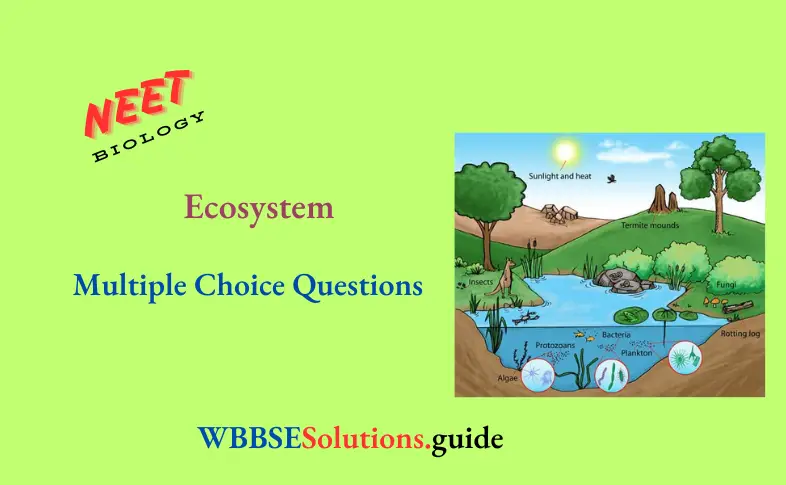
NEET Biology Ecosystem Miscellaneous MCQs with Answers
Question 4. Ability of the community to come back quickly to its original form is
- Resistance
- Resilience
- Disturbance
- Heterogeneity
Answer: 2. Resilience
Resilience is the capacity of an ecosystem to respond to a perturbation or disturbance by resisting damage and recovering quickly.
“ecosystems questions and answers “
Question 5. Match the following columns and select the correct option
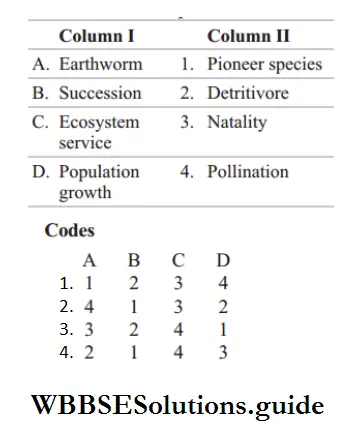
Answer: 4. 2 1 4 3
Important MCQs on Ecosystem for NEET
Question 6. In a grassland ecosystem, if the number of primary producers is approximately 6 million plants the number of top carnivore (in million) which may be supported by it may be
- 3
- 30
- 6
- 60
Answer: 1. 3
In a grassland ecosystem, the number of producers (mainly grasses) is always maximum, followed by decreasing numbers at second trophic level (herbivores), third trophic level (carnivores) and least number of apex predators.
Thus, 6 million producers would support about 3 million top carnivores.
NEET Biology Mcq Chapter Wise
Question 7. Match the terms with their definition given in columns.
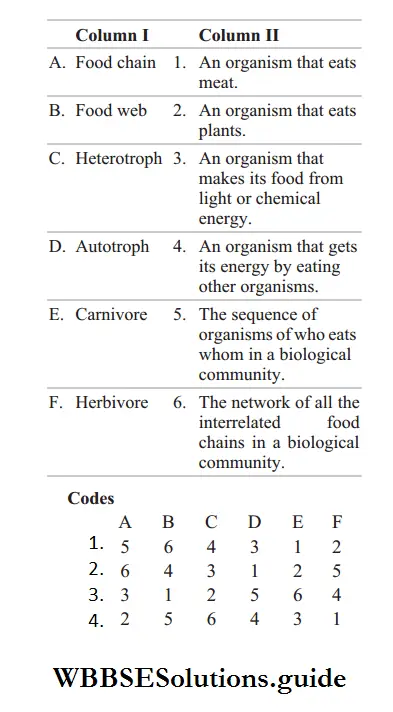
Answer: 1. 5 6 4 3 1 2
Components of an Ecosystem MCQs for NEET
Question 8. In the given formula, what does ‘a’ represent?
Assimilatory efficiency = \(\frac{Use of energy in food}{a}\) x 100
- Energy obtained through primary producer
- Biomass at own level
- Biomass at lower trophic level
- Energy obtained through food
Answer: 4. Energy obtained through food
Assimilatory Efficiency (AE) is the percentage of food energy assimilated for bodybuilding to total food ingested.
So, the formula AE = \(\frac{Use of energy in food}{Energy obtained through food}\) × 100
Ecological Productivity and Nutrient Cycling MCQs for NEET
Question 9. Match the following columns.
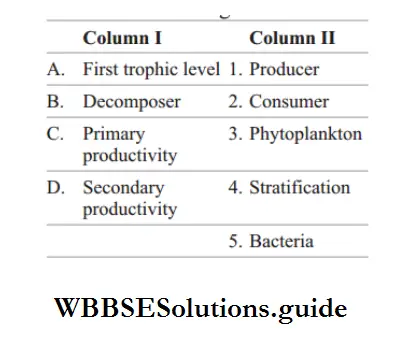
Codes
- 1 5 3 4
- 2 3 4 5
- 3 5 1 2
- 3 5 2 1
Answer: 3. 3 5 1 2
Read And Learn More: NEET Biology Multiple Choice Question And Answers
Question 10. Match the following columns.
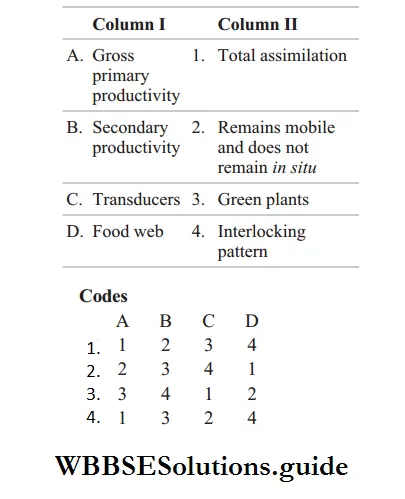
Answer: 1. 1 2 3 4
Topic-wise Ecosystem Miscellaneous MCQs for NEET with Explanation
Question 11. Match Column I with Column II and select the correct option.
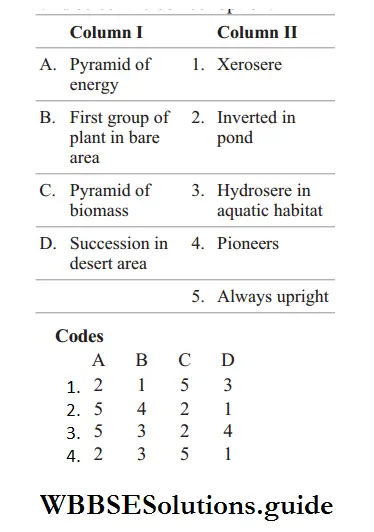
“ecosystems questions and answers “
Answer: 2. 5 4 2 1
NEET Biology Mcq
Question 12. Select the correct statement.
- Phosphorus cycle is an example of gaseous nutrient cycle
- The pyramid of biomass in sea is generally inverted
- By the process of humification, soluble inorganic nutrients go down into the soil horizon
- A given organism may not occupy more than one trophic level simultaneously
- Pyramid of energy is always inverted, can never be upright
Answer: 2. The pyramid of biomass in sea is generally inverted
- Statement in option 2 is correct, while all other statements are incorrect and can be corrected as:
- Phosphorus cycle is sedimentary nutrient cycle and its reservoir exists in earth’s crust.
- Humification is the formation of dark coloured humus from detritus. Water soluble inorganic nutrients go down into deeper layers of soil by leaching.
- A given organism may occupy more than one trophic level simultaneously.
- Pyramid of energy is never inverted.
NEET Biology Energy Flow and Food Chains MCQs
Question 13. If carbon dioxide is withdrawn from the biosphere, which organism would first experience negative effects?
- Primary producers
- Producers
- Secondary consumers
- Tertiary consumers
Answer: 2. Producers
In a terrestrial ecosystem, plant grows by manufacturing food from carbon dioxide of air, water and minerals of soil with the help of chlorophyll and sunlight. Hence, if carbon dioxide is withdrawn from the biosphere, producers would first experience negative effects.
Question 14. The term ‘homeostasis’ in an ecosystem refers to
- Feedback Mechanism
- Self-Regulatory Mechanism
- Influence Of Production
- State of equilibrium
Answer: 4. State of equilibrium
Homeostasis or state of equilibrium or balance of nature is maintained through a number of controls like carrying capacity self regulation and feedback system.
NEET Biology Mcq
Question 15. Which of the following does not contribute directly to the recycling pathways of trophic?
- Bacteria and fungi feeders
- Plants
- Carnivores
- Herbivores
Answer: 1. Bacteria and fungi feeders
“ecosystem question answer “
“questions about ecosystem with answers “
The trophic pathways are made up of species that share similar habitat requirements and complementary life history traits. Thus, bacteria and fungi feeders do not contribute directly to the recycling pathway of trophic.
Question 16. Full name of professor Misra who is known as the Father of Ecology in India is
- Ramesh Misra
- Ramavtar Misra
- Ramakant Misra
- Ramdeo Misra
Answer: 4. Ramdeo Misra
“pond ecosystem pyramid “
Ramdeo Misra is revered as the Father of Ecology in India. His research laid the foundations for understanding of tropical communities and their succession, environmental responses of plant populations and productivity and nutrient cycling in tropical forest and grassland ecosystems. He was honored with the prestigious Sanjay Gandhi Award for his great work in the field of environment and ecology.
Human Impact on Ecosystems and Conservation MCQs for NEET
Question 17. In our biosphere, the most important and vast area is covered by hydrosphere. Hydrosphere has
- 1.4 billion cubic km of water
- 1.4 million cubic km of water
- 2.5 billion cubic km of water
- 1.5 billion cubic km of water
Answer: 1. 1.4 billion cubic km of water
More than 70% of earth’s surface is covered by water. There is about 1.4 billion cubic kilometre of water in the hydrosphere. Of this, about 97% is ocean water and only 3% is freshwater.
